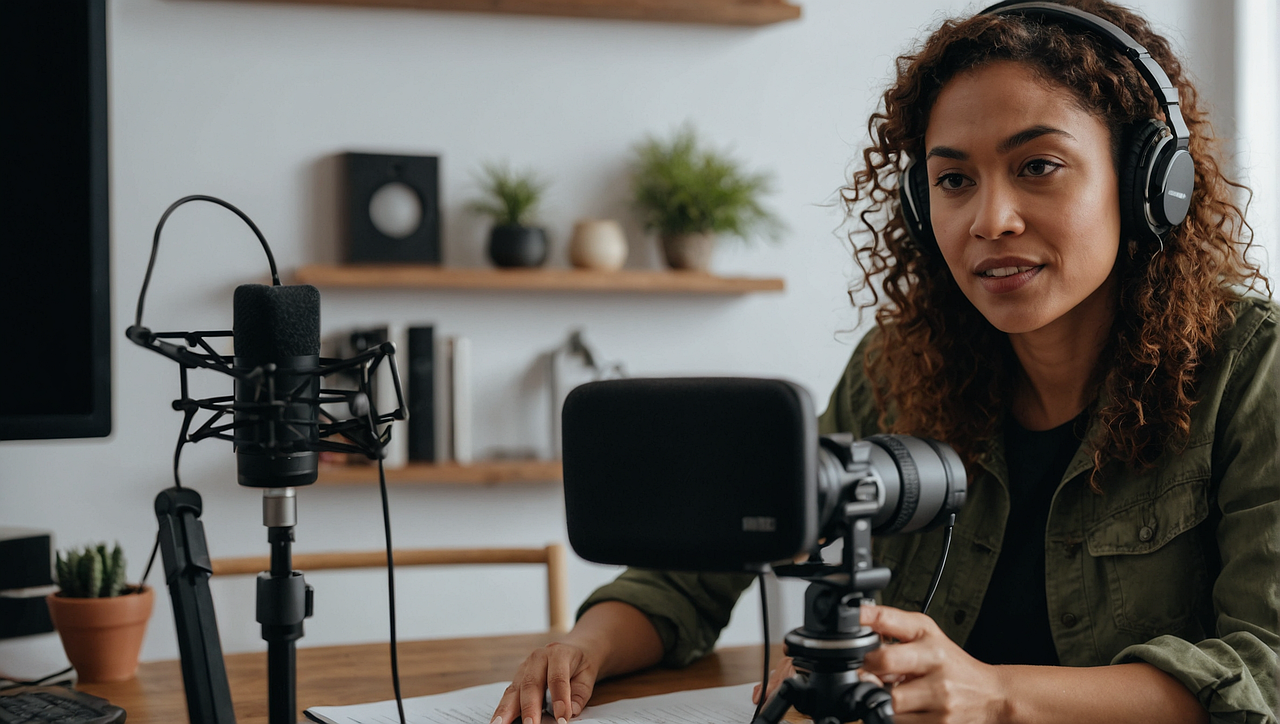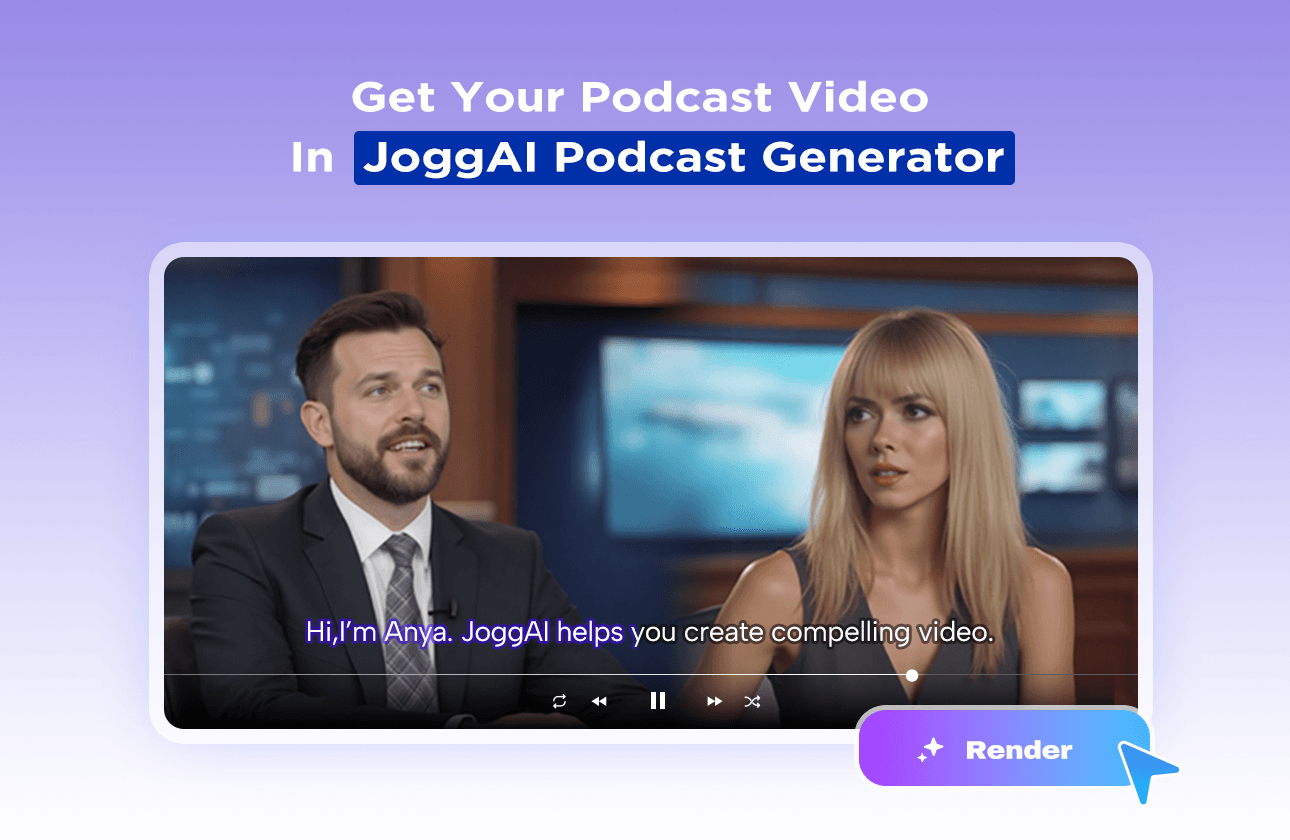
数字人制作

文本生成数字人

视频克隆数字人

照片克隆数字人

数字人库
视频创作

文本转视频

链接转视频

AI广告生成器

AI声音克隆
渠道代理
API集成
A vodcast is a video podcast that combines pictures and sound, making it an effective tool to grab attention and keep people engaged. Did you know that videos account for 82.5% of internet traffic? With this high demand, using a vodcast generator to create engaging content is a fantastic way to reach audiences online.
A vodcast is a video podcast that mixes sound and pictures. This format makes content more fun and interesting to watch. Unlike regular podcasts, vodcasts use visuals to tell stories better. They also help connect with viewers in a stronger way. But what makes a vodcast special? Let’s look at its main parts, how people watch it, and why it works so well.
To make a great vodcast, you need some key tools. Good video and sound are the most important. Clear pictures grab attention, and good sound keeps people listening. Bad quality can make viewers leave.
Here’s what you’ll need to start:
A good camera for clear pictures.
A good microphone for clear sound.
Bright lights to make your video look nice.
Editing tools to improve your video.
A tripod to keep your camera steady.
Planning is also very important. Pick a theme for your vodcast, know who will watch it, and plan your topics. This will help you stay on track and give your viewers something valuable.
Vodcasts are shared on many platforms, so lots of people can see them. Popular places to share vodcasts include YouTube, Spotify, and Apple Podcasts. These platforms let you reach millions of viewers who already enjoy video podcasts.
People can watch vodcasts on phones, tablets, or computers. Some like watching while traveling, and others prefer watching at home. This flexibility makes vodcasts a favorite for creators and viewers.
Vodcasts have cool benefits that regular podcasts don’t. The video part helps you connect with viewers in a personal way. For example, you can show pictures to explain hard ideas or display products. This makes your content more fun and easy to follow.
Features like live chats and comments make vodcasts even better. You can talk to your viewers right away, which builds a community. Vodcasts also spark conversations, making viewers feel included and important.
In short, vodcasts mix sound and video to make content exciting. It’s no surprise that video podcasts are becoming so popular!
The main difference between a vodcast and a podcast is video. A vodcast uses video to make content more interesting. Videos can show facial expressions, body language, or product demos. This helps your audience connect with you better. It also makes your message easier to understand. For example, vodcasts often use visuals to explain hard ideas or tell fun stories.
Studies say visuals help people remember and learn better. They also make your content stand out. If you want to grab attention, adding video is a smart choice.
People expect different things from vodcasts and podcasts. Podcasts are great for multitasking. You can listen while driving, exercising, or cleaning. Vodcasts, however, need your full attention because they use video. This makes them perfect for tutorials or interviews.
Popular vodcasts often have live chats or interactive features. These make viewers feel like part of a group. When making a vodcast, think about how to use visuals and interaction to meet these needs.
Making a vodcast takes more work than a podcast. For a podcast, you just need a microphone and simple software. A vodcast needs cameras, lights, and advanced editing tools. This makes vodcasts cost more to create.
Here’s a simple comparison:
| Aspect | Vodcasting | Traditional Podcasting |
|---|---|---|
| Format | Uses both video and audio | Audio-only, like a radio show |
| Consumption | Needs a screen to watch | Listened to with headphones or speakers |
| Engagement | Uses visuals and body language | Focuses on audio storytelling |
| Content Type | Best for visually rich topics | Covers interviews and discussions |
| Production | Needs more advanced equipment | Can use basic tools |
If you’re new, starting with a podcast is easier. But if you’re ready to spend more, a vodcast can improve your content.

Take time to plan before starting your vodcast. Pick a topic you enjoy and know well. Think about your audience—what do they like or need? Decide if you’ll host alone, with a cohost, or invite guests. Each option has its own benefits, so choose what works best for you.
Make a schedule for your episodes. Plan fun and useful topics to keep viewers interested. Test your ideas before filming to make sure they work. Preparing ahead helps you create better vodcasts.
You’ll need some tools to make a vodcast. A good camera is important for clear video. If you don’t want to spend much, use a smartphone or webcam. Pair it with a microphone for clear sound. Lighting matters too—use ring lights or sunlight for a professional look.
Get a computer with editing software like iMovie or Adobe Premiere Pro. A green screen can add cool backgrounds to your videos. Use a tripod to keep your camera steady. With these tools, you’re ready to start filming.
Recording is where the fun begins. Film in a quiet place with good lighting. Check your camera and microphone settings before starting. Speak clearly and stay energetic to connect with viewers.
After recording, edit your video to make it better. Cut out mistakes, add effects, and improve visuals. If you’re new to editing, watch tutorials to learn. Good editing makes your vodcast look professional.
Once your vodcast is edited, publish it online. Share it on platforms like YouTube or Spotify to reach more people. Write catchy titles and descriptions to grab attention. Promote your vodcast on social media by sharing clips or teasers. Teaming up with other creators can help grow your audience.
Want an easier way to make vodcasts? Try JoggAI’s Video Podcast Generator. This tool helps you create great vodcasts quickly. It’s perfect for beginners and experts. JoggAI handles the hard parts, so you can focus on your ideas.

Starting a vodcast opens up exciting opportunities to connect with audiences. You’ve learned that vodcasting combines audio and video to create engaging content. It’s a growing trend, with video making up 82.5% of global internet traffic.
Here’s why you should dive in:
Vodcasts are shareable and can go viral.
They help build your audience and boost your brand.
Take the first step today. Plan your niche, grab your equipment, and start creating!
YouTube is a great choice. It’s free, user-friendly, and has a massive audience. Other platforms like Spotify and Apple Podcasts also support video podcasts.
Choose topics that need visuals, like tutorials, product reviews, or interviews. Think about what your audience enjoys watching and create content around those interests.
No worries! Start with what you have. A smartphone, natural lighting, and free editing tools can help you create a quality vodcast without breaking the bank.
Tip: Focus on improving your skills over time. Better content matters more than fancy gear!



